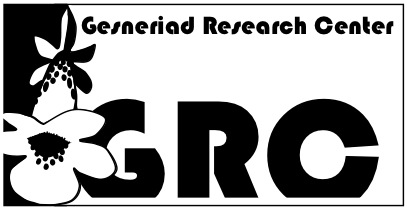
The Interface Zone: solid line indicates an area known as the "Fijian Region." The "Interface Zone" includes all of the Fijian Region plus the area enclosed by the dashed line (Fig. 1 from Clark, J.R. 2008. Gesneriads at the edge of the world...with notes on current research at Selby Gardens. Gesneriads 58: 35-38).
By John R. Clark
By now, many Gesneriad Society Members have received the newest issue of Gesneriads. On page 35 there is an article on our signature research project at the GRC: Gesneriads of the Interface Zone. We are in the process of securing funding for this project through competitive grants and philanthropic individuals. If you or someone you know may be interested in participating or supporting us in this monumental project, please contact me.
Okay...here's a bit of an overview of what we are planning to do (just in case some of our blog readers don't receive Gesneriads):
Comparative study between related lineages of organisms that differ in their ability to colonize islands can provide valuable insight into how geography may be affecting speciation. The flowering plant family Gesneriaceae (African violets and their relatives) provides a unique opportunity to examine island colonization in relation to the evolution of species: although gesneriads are found distributed throughout all of the world’s tropical forests, only one genus, Cyrtandra, has colonized the remote Pacific Islands. Cyrtandra is the most species-rich genus of gesneriad (>500 species) and has the greatest single range for any genus in the family, extending from the Nicobar Islands in the Indian Ocean to the distant Hawaiian and Marquesan Islands in the Pacific. The broad distribution and large number of species in Cyrtandra is in marked contrast to other gesneriads, including the genera Aeschynanthus (±185 sp.), Boea (±14 sp.), Coronanthera (±11 sp.), and Epithema (±20 sp.), that reach their easternmost extent in the Solomon Islands. For these gesneriads, the southeast Asia-Pacific Interface Zone is effectively the “edge of the world.”
The Interface Zone, centered on Fiji and including the Solomon Islands, Vanuatu, New Caledonia, Tonga, and Samoa (as well as other associated islands), has been implicated as a center of origin for the Pacific species of Cyrtandra (Clark, J.R. et al. 2008. Syst. Biol. 57:693-707). Results from these evolutionary analyses suggest that once the barrier to Pacific dispersal within the Interface Zone had been overcome, Cyrtandra was well suited for island hopping and continued to do so across the expanse of the Pacific. As intriguing as this scenario is, the data supporting it are preliminary and additional species sampling and further analyses are required. Likewise, the other genera of gesneriads from the interface zone are poorly known and similar evolutionary analyses have not been conducted as a result. Intensive species sampling within the interface zone, principally in the Solomon Islands and Fiji, is vital to address the questions of how and why Cyrtandra dispersed throughout the Pacific while a diverse assemblage of related gesneriads did not.
In collaboration with representatives from the Solomon Islands and Fiji, we are proposing detailed sampling and collection of the gesneriads Aeschynanthus, Boea, Coronanthera, Cyrtandra and Epithema in critical areas of the Solomon Islands (the islands of Guadalcanal, New Georgia, Santa Isabel, Choiseul) and Fiji (the islands of Viti Levu, Vanua Levu, and Taveuni) beginning in July of 2009. The Solomon Islands represents the easternmost range for all genera under consideration, excluding Cyrtandra, and Fiji is the hypothesized first step into the Pacific by Cyrtandra. Data to be collected include herbarium specimens, silica gel-dried leaf tissue, alcohol-preserved flowers and fruits, living collections, and locality/habitat information. This fieldwork will be critical for completing comprehensive evolutionary studies on these genera and are required for detailed analysis and testing of the center of origin hypothesis for Cyrtandra as well as for developing parallel hypotheses in related gesneriad genera.
Stay tuned to the GRC blog for updates on this and other exciting projects involving gesneriad research at Selby Gardens.




